
|
|
||||||||
Single-malt or blended, sir?
 |
|
The R6 is definitely a good track tool, but can it be used for anything else? |
So you you’d like a 600, something sporting, and you hope to simplify your choices by choosing the brand first – Yamaha, for instance.
Bad call, if you’re trying to make things easy.
Yamaha offers four 600 cc inline fours in Canada, ranging from $9,299 for the FZ6 (Yamaha: “a brilliant all-round motorcycle that combines exciting performance … with an incredible level of riding comfort”) to $12,499 for the latest incarnation of the wickedly-fast, race-oriented R6 (“one of the most advanced middleweight sport bikes ever built”).
In between we have the YZF600R (“a mid-range bike with a race track heritage” at $9,999), and the R6S (a new name for the 2006 R6, available as an ’07 model at $11,599).
What to do? It’s all very well to suggest that you should look for a bike that suits your style of riding and the flexibility of your back, but when three of these four offerings are bases for production racers, it would seem that things are getting chopped pretty fine – particularly between the two R6 models.
To simplify things, we took a quick look at the two extremes, the FZ6 and the R6.
History
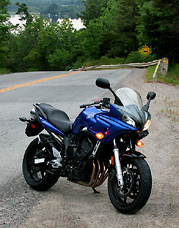 |
|
FZ6 – Usability with sport characteristics? |
The FZ6 was introduced in 2004 as a budget middleweight, based loosely on the spectacularly successful Fazer 600 (a Europe-only model). It was marked by a new engine – a version of the then-current R6 engine (now R6S) – mounted in an unusual bolted-up (rather than welded) cast aluminum frame. With its strong engine but relatively sedate riding position and simple suspension, it was positioned as a less extreme, more practical, but still a quick 600.
For 2007, the bike got freshened up with a typically-Yamaha raptor-like appearance, upgraded front brakes, slightly revised fork damping, and a new swingarm. Of course, we did the test last year, so you'll have to bear with the 2006 model for this test.
The R6 was all-new for 2006, featuring all the goodies you’d expect on a modern cutting-edge sportbike – 16,000 rpm engine, lightweight welded Deltabox aluminum frame, fully adjustable suspension (including adjustments for high and low speed compression damping), trick brake calipers with radial mounts powered by a Brembo radial master cylinder, “fly by wire” throttle control – the list goes on. This one, and its R6S predecessor, are really street bikes in name only. They were built to win production races, and the fact that they can be ridden on the street is barely relevant to their mission statement.
Ergos
 |
|
FZ6 motor comes from the previous R6. |
Despite minor changes, the FZ6 hasn’t changed a lot in spirit, intent, or utility. Test riders of all sizes liked the riding position. The tubular bars are low enough to cant your upper body forward but high enough to be comfortable at low speeds or in city riding, the pegs are far enough back to get your feet away from the pavement without cramping taller riders too much, and the seat is acceptable, even for two-up riding – it's certainly better than any 600 cc pure sport bike.
Ergonomically, this is a fine example of what these days is often called a “naked” bike, and the owner of a Suzuki Bandit or a Triumph Speed Triple would feel right at home on it.
By contrast, the R6 is close-coupled, tight, almost cramped. Clearly, it’s been designed with mass centralization in mind for faster corner tip-in and lighter handling feel – a wheelbase measurement of 1,380 mm vs 1,440 for the FZ6 tells you something right there. Rake and trail are steeper and shorter as well (24 degrees vs 25; 97 mm vs 97.5), although the difference in feel between the two bikes would suggest an even greater variance.
 |
|
Passenger friendly ... |
Don’t try carrying a passenger on the R6, and don’t count on riding very far in any case, unless you like frequent breaks. The seat appears to have been designed purely to keep your ass out of the fuel injection system. It does that quite well.
Engines
These motorcycles are about as different as you can imagine, 600 cc chips from the same company block or not. Both use EFI, and both start and run instantly – no choke needed. The FZ6 engine is pretty much identical to the last-generation R6 (now the R6S) except for different cam profiles, intake lengths, and fuel injection systems. The first two factors are intended to increase torque numbers and lower the torque peak, while the latter is mostly a cost-saving measure, though it works flawlessly.
The R6, however, incorporates every trick this side of a Moto GP bike, including “fly by wire” throttle control (Yamaha claims that the injectors and throttle system are directly descended from Rossi’s bike), super-lightweight everything, friction-fighting materials, slipper clutch, and the infamous redline, now said to be 16,000 rpm after an initially overenthusiastic PR claim of 17,000. Lowered redline or not, this bike pulls hard in the upper ranges.
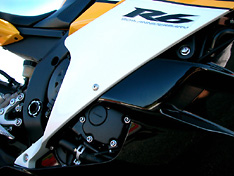 |
|
Bit highly strung? |
On the track, that is, where kept on the boil the engine is absolutely frantic and fantastic. This is one wicked-sounding machine when it’s being twisted. But on the street, the R6 engine is a pooch, feeling more like a 250 unless you’re the kind of rider who likes to go through school zones at 12,000 rpm.
Big power in a 600 comes with lots of revs and not much bottom end; that’s just the way it is, and that sucks on the street. A road speed of 100 km/h is less than 6,000 rpm in sixth, and the bike is positively weedy at those revs and unimpressive anywhere below 10,000 rpm.
The “older” FZ6 power plant, on the other hand, is a model of 600 cc civility in everyday use. It pulls well from about 6,000 and really starts to yank hard at 7,000 – still revvy to be sure, but much stronger lower down than most modern 600s – and it will scream up to 14,000 rpm.
 |
|
FZ6 proved to be plenty able on the track too. |
Both bikes have six-speed transmissions that work perfectly. Light, smooth shifts either way with a light clutch pull, making gear changes a pleasure. A span adjustment on the FZ6 clutch would be welcomed by riders with small hands, but overall it's good stuff.
Suspension
The R6 is fitted with Ohlins suspension – expensive, multi-adjustable units that approach perfection. There are so many adjustments, in fact, that most riders would be better off leaving the default settings in place. Suspension guru John Sharrard tells us this feature is more than a gimmick – but unless you’re good enough to be racing at the sharp end of the grid, we doubt you’ll accomplish anything useful by fiddling with them.
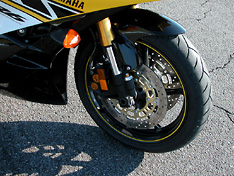 |
|
There's Ohlins there. |
On the track is where this matters, of course, and out there the R6 is sublime. One former Pro racer who tried it at Mosport claimed that it felt like a 250 cc GP bike with mid-range. He was also impressed by how mechanically simple it was to make all the suspension adjustments he wanted.
Mind you, he despised the bike on the street. The engine that was so potent on the track had no power at street-going mid-range revs, and the seating position that feels so good at Mosport is punishing on public roads.
The FZ6 is the polar opposite of its nastier sibling, with a friendly “what, me worry?” attitude on the road. The fork is not adjustable, but works well for a wide variety of riders. The rear is adjustable seven ways for preload only, via the usual ramped collar, so if you’re going to weigh it down with a passenger or gear, you can bump up the spring tension.
 |
|
Not Ohlins. |
At a less-than-R6 pace on the track, the bike is enjoyable. Push hard, and it soon gets confused and overwhelmed, feeling sloppy and budget-based after a session on the R6. But a photo session at Shannonville carrying Mr. Seck (who’s no lightweight) as photographic buddy-baggage didn’t cause any drama. We’d call it a good, solid street package that should be fine for anyone who’s not skilled at suspension twiddling.
Brakes
The current FZ6 brakes are a theoretical improvement over those of older models, up to four-piston calipers from two, but we didn’t notice a lot of difference. Like the transmission, they work fine, with good response and feedback.
There is an adjustable span on this one, same as on the R6 – but the stoppers on the R6 are even better, as you might expect from the specs and their intended use. On the track, they deliver excellent feel when trail-braking deep into a corner, and they are supremely powerful.
Convenience, comfort, what-not
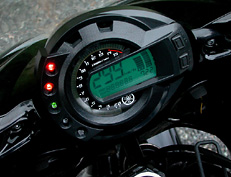 |
|
FZ6 instrument cluster. |
The FZ6 comes with a centrestand, as it should and as many current chain-drive bikes don’t. Even better, it’s easy to use and is tucked in far enough that the peg feelers touch down before the stand.
The instruments are mostly the usual nice clean devices, albeit in rather an odd-shaped pod. The exception is the tachometer, which is one of those horrible electronic circular bar things. Black on grey, and almost impossible to read in daylight, though not bad at night, being backlit. Even Yamaha seems to think it’s not very good, as there’s also a little numeric display for revs, though it's impossible to read when you’re trying to ride quickly and watch the road. We miss the old analog rev counters, which could be read easily and reliably.
Mirrors are okay on the FZ6, but useless on the R6 unless you like admiring your elbows and shoulders. A few vibes get through to the rider on both bikes – they both use solidly-mounted engines – but nobody who rode either bike complained about them.
 |
|
R6 looks the part. |
Wind protection is surprisingly good on the FZ6. There’s not a lot of fairing there, but it does a pretty good job of smoothing out the airflow, and actually knocking a fairly big hole in the air to start with. The R6, on the other hand, is again a track bike – you have to be traveling at seriously illegal speeds to get any wind protection or get the load off your wrists, and even then the wind blast hits right at a taller rider’s head. Still, its fairing was not designed for touring.
This is the end, my friend
Having said all that, it must be restated that the bikes are clearly aimed at entirely different zones. Although you can make either one work on either road or track, you really do have to decide if you want a track bike or a street machine.
If you’re a good enough racer you could probably take a stock R6 and finish in the top half dozen at a regional race; the thing really is that good. The FZ6 is nowhere near that competent, but still a fine bike for relaxed track days.
 |
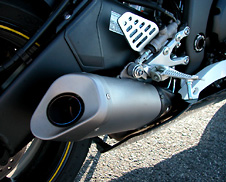 |
|
FZ6 (top) gets underseat exhausts. R6 goes GP style. |
On the other hand, the FZ6 is a great day-to-day bike, is definitely something you might take touring, and would be a useful and comfortable commuter. While the R6 can also be used in those ways, the younger, shorter, and more limber you are, the more likely you are to enjoy the ride.
We’ll take one of each, please, in our normal, equivocating CMG sort of way. The single-malt R6 is a more intense experience, while the blend of tastes in the FZ6 has perhaps a more enduring charm.
2007 changes
Whenever we happen to hold a test ride over the winter we always seem to pick the one that gets changed the following year. In this comparo, it's the FZ 6 that got the revamp with some styling changes, a re-designed seat, changed (roomier) footpeg location for passengers, revised fuel-injection mapping for more power and three catalysts in the exhaust for reduced emissions. Plus, brakes have been upgraded to more current “monoblock” spec which should prove useful and there’s a new swingarm as well.
Hmhh, maybe we should just post when we do the test and not worry about trying to spread them out over the year ... sigh.
COMPARITOR
|
Specifications |
FZ6 (2007 model) | R6 |
Comments |
|
MSRP |
$9,299.00 | $12,499.00 |
Over
three grand more for the R6 but do you get what you'd actually use?
|
|
Displacement |
600 cc | 600 cc |
Odd.
You'd expect 599 cc but Yamaha reckon 600.
|
|
Engine type |
Inline dohc four, liquid-cooled | Inline dohc four, liquid-cooled |
Based
on the same DNA.
|
|
Carburetion |
Fuel Injection | Fuel Injection |
Fascinating.
|
|
Final drive |
Six speed, chain drive |
Six speed, chain drive |
Yes,
very interesting.
|
|
Tires, front |
120/70 ZR17 | 120/70 ZR17 |
Yep,
the same.
|
|
Tires, rear |
180/55 ZR17 | 180/55 ZR17 | |
|
Brakes, front |
Dual 298 mm discs with four piston calipers | Dual 310 mm discs with four piston calipers |
Ah, a difference!
Okay, the R6 has the latest and greatest, with more power up front
where you need it on a track-orientated bike. For 2007, the FZ6
gets the R6 calipers but the disc sizes remain the same.
|
|
Brakes, rear |
Single 245 mm disc with single piston caliper | Single 220 mm disc with single piston caliper | |
|
Seat height |
795 mm (31.3") | 850 mm (33.5") |
That's
a pretty tall seat height even for a sport 600.
|
|
Wheelbase |
1,440 mm (56.7") | 1,380 mm (53.4") |
Tighter
wheelbase = greater flickability at the cost of general stability.
|
|
Dry
weight |
186 Kg (409 lbs) (claimed) | 162 Kg (356 lbs) (claimed) |
I
think that's where a chunk of that three grand was spent.
|
|
Colours |
Blue; Deep Metallic Red | Blue; Deep Metallic Red; Dark Metallic Bluish Grey |
No
comment.
|
|
Horsepower |
98
hp @ 12,000 rpm
|
133
hp @ 14,500 rpm
|
And there
we have the rest of your three grand. What the figures don't tell
you is where that power comes in, and with the FZ6 that's a lot
lower down the rev scale (spinning up a motor will generally get
you higher power figures). Again, what do you want to use your
600 for?
|
|
Torque |
46.5
ftlb @ 10,000 rpm
|
50
ftlb @ 12,000 rpm
|
|
| Warranty |
12
months
Unlimited Km |
12
months
Unlimited Km |
Don't break it on month 13. |
![]()